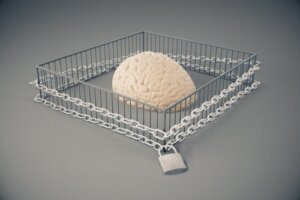What Are Inflexible Standards?


Written and verified by the psychologist Maria Fatima Seppi Vinuales
We often maintain ideas, beliefs, and even rules because they provide us with a framework of security and give us peace of mind. However, this mental framework may become rigid and watertight. Then, we’re facing inflexible standards.
These standards often are held despite severe consequences and even at the cost of our well-being. They can really harm us. Let’s take a closer look at why.
Schema therapy as a framework
J. Young, in his schema therapy, discovered that people develop a way of interpreting the world and explaining reality during their childhood. Schemas are these ways of thinking about oneself and others.
Schemas are made up of memories, emotions, and bodily sensations. They are repeatedly experienced throughout life.
However, sometimes they’re transformed into maladaptive early schemas (EPD), making them dysfunctional for the person. These schemas originate in response to unmet emotional needs, which are related to secure attachments, autonomy, freedom to express oneself, spontaneity, and boundaries.
Young postulates the existence of 18 schemas, distributed in 5 categories. Within these categories, we find overvigilance and inhibition, in which the following dysfunctional schemas are found:
- Negativity and pessimism
- Emotional inhibition
- Inflexible standards

We think you may also enjoy reading this article: 10 Negative Effects of Stress on Your Health To Keep in Mind
What are inflexible standards?
Inflexible standards are rigid behavior that responds to severe internal norms. They often involve sacrificing well-being and happiness just to fulfill them.
In addition, people with inflexible standards are those who find it difficult to incorporate a point of view different from their own, especially when it contradicts their own standards.
All people find it difficult to change their minds when it comes to certain issues. However, there’s a downside when we become completely rigid in our thinking. This prolongs the difficulty in finding a new solution to a problem.
Of course, in the same situation, two people may have different schemes. The resolution depends on many other factors, involving temperament and contextual conditions. For example, in cases of perfectionism or OCD (obsessive-compulsive disorder), there is a predominance of this rigid cognitive style.
Like this article? You may also like to read: Five Strategies for Turning the Negative into Positive
Characteristics of people with inflexible standards
Among the main characteristics of people with inflexible standards are the following:
- They possess low tolerance for frustration.
- They have a tendency to be severely self-critical.
- There’s exaggerated compliance with rules.
- They tend to hide emotions and feelings.
- They respond well to demanding patterns and are governed by a sense of duty.
- They’re closed and they find it difficult to change and adapt to circumstances. In general, they tend to stay within their comfort zone.
Some scientific studies and theses have sought to establish the possible relationship between dysfunctional schemas in childhood and adolescence (including inflexible standards) with current and future behaviors.
Along these lines, research in Peru postulates that aggressiveness is more frequent among young people with dysfunctional schemas. In this same country, in the 15-17 age group, inflexible standards were found to be highly prevalent: 66.4%.
The consequences of inflexible standards
To understand how inflexible standards influence a person’s life, let’s look at an example.
Someone who experienced certain economic and material hardship throughout his or her childhood feels reassured when saving money. In doing so, he or she experiences a sense of control over his or her future. However, this person is unable to enjoy other advantages that money can bring them, such as planning a vacation or renovating their home. Their standards are inflexible and governed by a single belief: hoarding. In this way, the perseon deprives themselves of enjoying pleasurable experiences and once again returns to the original situation: they feel financially deprived because of their inflexibility.
The main consequence of having inflexible standards is that both occupational and economic opportunities are lost. Since it’s so difficult to innovate and think “outside of the box”, the person’s creativity and problem-solving suffer.
Sometimes, people with these schemes often experience difficulties in their interpersonal relationships. Their rigid and rigid way of being and thinking prevents them from taking responsibility for changing certain things or accepting others.
It’s also true that it’s often difficult for them to relax. They are very critical, so this is also a problem when it comes to connecting with the enjoyment of present situations.
Mental schemas are capable of changing the physiological functioning of the body, as well. In women with inflexible standards, an increase in the amount of the hormone cortisol in the blood was found. This increase can have different health consequences, as elevated cortisol is associated with sleep disorders, increased risk of dementia in aging, obesity, and insulin resistance.

Questioning the norm can help make our responses more flexible
The decisions we make should try to follow a trend toward balance and never reach an extreme. Rigidity is often the cause of our inability to find a way out of problems. Thus, we repeat the same dysfunctional solutions over and over again.
On the contrary, flexibility allows us to adapt to new situations and to move away from our previous attempts. We understand that we can try other strategies.
Faced with such hermetic thinking styles, it’s very important to start by questioning these pseudo-truths, these internal mandates that hinder change. Cognitive therapy and schema therapy can help us to do this.
All cited sources were thoroughly reviewed by our team to ensure their quality, reliability, currency, and validity. The bibliography of this article was considered reliable and of academic or scientific accuracy.
- Caputto, Ileana, Cordero, Soledad, Keegan, Eduardo, & Arana, Fernán. (2015). PERFECCIONISMO Y ESQUEMAS DESADAPTATIVOS TEMPRANOS: UN ESTUDIO CON ESTUDIANTES UNIVERSITARIOS. Ciencias Psicológicas, 9(2), 245-257. Recuperado en 30 de diciembre de 2021, de http://www.scielo.edu.uy/scielo.php?script=sci_arttext&pid=S1688-42212015000300003&lng=es&tlng=es.
- Ghisio, M. S., Ludtke, L., & Seixas, C. E. (2016). Análise comparativa entre a Terapia Cognitivo-Comportamental e a Terapia do Esquema. Revista Brasileira de Psicoterapia, 18(3), 17-31.
- Gomez Chagua, Y. (2020). Relación entre esquemas desadaptativos tempranos y dimensiones de dependencia emocional en adolescentes de quinto año de secundaria.
- Osorio, L. P. C., & Calvet, M. M. (2019). Esquemas maladaptativos tempranos y agresividad en estudiantes de secundaria de Lima Metropolitana. Persona, (022 (2)), 45-66.
- Ouanes, S., & Popp, J. (2019). High cortisol and the risk of dementia and Alzheimer’s disease: a review of the literature. Frontiers in aging neuroscience, 11, 43.
- van Rossum, E. F. (2017). Obesity and cortisol: new perspectives on an old theme. Obesity, 25(3), 500.
- Young, J. & Klosko, J. (2007). Terapia de esquemas. En J.M. Oldham, A.E. Skodol & D.S. Bender (Eds), Tratado de los trastornos de la personalidad (pp. 289-308). Barcelona: Elsevier Masson.
- Zapata Yance, L. F., Parra De La Rosa, K., Barrios, D., & Rojas Santiago, M. (2016). Efecto de la Violencia y Esquemas Cognitivos en el Cortisol de Mujeres Violentadas por sus Parejas. Universitas Psychologica, 15(SPE5), 1-10.
This text is provided for informational purposes only and does not replace consultation with a professional. If in doubt, consult your specialist.








